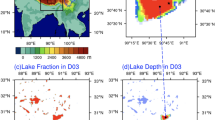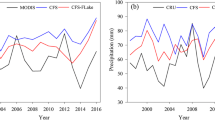Abstract
This paper evaluates the performance of the Weather Research and Forecasting (WRF) model coupled with a lake scheme over the Lake Poyang and Lake Dongting regions. We choose several cases with different weather characteristics, including winter with/without precipitation and summer with/without precipitation, and conduct a series of experiments (without the lake model, with the default lake model, and with a calibrated lake model that adjusts the water absorption, extinction coefficients, and surface roughness length) for each case. The results show that the performance of the lake model is significantly affected by the weather conditions. For the winter with precipitation cases, the performance of the default lake model is even worse than without the lake model, but the calibrated lake model can obviously reduce the biases of 2-m temperature and dew-point temperature. Although the performance of the default and new calibrated models is intricate for other cases, the new calibrated model has prominent advantages for 2-m dew-point temperature. Moreover, a long-term simulation of five months also shows that the new calibrated coupled lake model performs better than the default one. These imply that the new calibrated coupled lake model is more suitable to be used in studies of the effects of Lake Poyang and Lake Dongting on regional weather and climate.
Similar content being viewed by others
References
Balsamo, G., R. Salgado, E. Dutra, et al., 2012: On the contribution of lakes in predicting near-surface temperature in a global weather forecasting model. Tellus A, 64, 15829, doi: 10.3402/tellusa.v64i0.15829.
Bullock, O. R. Jr., K. Alapaty, J. A. Herwehe, et al., 2014: An observation-based investigation of nudging in WRF for downscaling surface climate information to 12-km grid spacing. J. Appl. Meteor. Climatol., 53, 20–33, doi: 10.1175/JAMC-D-13-030.1.
Deng, B., S. D. Liu, W. Xiao, et al., 2013: Evaluation of the CLM4 lake model at a large and shallow freshwater lake. J. Hydrometeorol., 14, 636–649, doi: 10.1175/JHM-D-12-067.1.
Dutra, E., V. M. Stepanenko, G. Balsamo, et al., 2010: An offline study of the impact of lakes on the performance of the ECMWF surface scheme. Boreal Environ. Res., 15, 100–112.
Fu, M. N., 2013: Research on the impacts of Poyang Lake on typical weather process and the characteristics of near surface boundary layer. Ph. D. dissertation, Nanjing University of Information Science & Technology, 100 pp. (in Chinese)
Gao, Y., J. S. Fu, J. B. Drake, et al., 2012: Projected changes of extreme weather events in the eastern United States based on a high resolution climate modeling system. Environ. Res. Lett., 7, 044025, doi: 10.1088/1748-9326/7/4/044025.
Gu, H. P., X. S. Shen, J. M. Jin, et al., 2014: An application of a 1-D thermal diffusion lake model to Lake Taihu. Acta Meteor. Sinica, 71, 719–730, doi: 10.11676/qxxb2013.051.
Gu, H. P., J. M. Jin, Y. H. Wu, et al., 2015: Calibration and validation of lake surface temperature simulations with the coupled WRF-lake model. Climatic Change, 129, 471–483, doi: 10.1007/s10584-013-0978-y.
Gu, H. P., Z. G. Ma, and M. X. Li, 2016: Effect of a large and very shallow lake on local summer precipitation over the Lake Taihu basin in China. J. Geophys. Res. Atmos., 121, 8832–8848, doi: 10.1002/2015JD024098.
Gula, J., and W. R. Peltier, 2012: Dynamical downscaling over the Great Lakes basin of North America using the WRF regional climate model: The impact of the great lakes system on regional greenhouse warming. J. Climate, 25, 7723–7742, doi: 10.1175/JCLI-D-11-00388.1.
Heikinheimo, M., M. Kangas, T. Tourula, et al., 1999: Momentum and heat fluxes over lakes Tämnaren and Råksjö determined by the bulk-aerodynamic and eddy-correlation methods. Agric. For. Meteor., 98-99, 521–534, doi: 10.1016/S0168-1923(99)00121-5.
Henderson-Sellers, B., 1986: Calculating the surface energy balance for lake and reservoir modeling: A review. Rev. Geophys., 24, 625–649, doi: 10.1029/RG024i003p00625.
Hong, S. Y., and J. O. J. Lim, 2006: The WRF single-moment 6-class microphysics scheme (WSM6). J. Korean Meteor. Soc., 42, 129–151.
Hostetler, S. W., and P. J. Bartlein, 1990: Simulation of lake evaporation with application to modeling lake level variations of Harney–Malheur Lake, Oregon. Water Resour. Res., 26, 2603–2612, doi: 10.1029/WR026i010p02603.
Hostetler, S. W., G. T. Bates, and F. Giorgi, 1993: Interactive coupling of a lake thermal model with a regional climate model. J. Geophys. Res. Atmos., 98, 5045–5057, doi: 10.1029/92JD02843.
Hostetler, S. W., F. Giorgi, G. T. Bates, et al., 1994: Lake–atmosphere feedbacks associated with paleolakes Bonneville and Lahontan. Science, 263, 665–668, doi: 10.1126/science.263.5147.665.
Kain, J. S., 2004: The Kain–Fritsch convective parameterization: An update. J. Appl. Meteor., 43, 170–181, doi: 10.1175/1520-0450(2004)043<0170:TKCPAU>2.0.CO;2.
Klaić, Z. B., and M. Kvakić, 2014: Modeling the impacts of a man-made lake on the meteorological conditions of the surrounding areas. J. Appl. Meteor. Climatol., 53, 1121–1142, doi: 10.1175/JAMC-D-13-0163.1.
Li, R., J. Jin, S. Y. Wang, et al., 2014: Significant impacts of radiation physics in the Weather Research and Forecasting model on the precipitation and dynamics of the West African Monsoon. Climate Dyn., 44, 1583–1594, doi: 10.1007/s00382-014-2294-2.
Lin, B. Y., and M. X. Li, 1988: Characteristic feature of the lakeland breeze and its effect on precipitation over the Dongtinghu Lake. J. Nanjing Inst. Meteor., 11, 78–88. (in Chinese)
Lofgren, B. M., 1997: Simulated effects of idealized Laurentian Great Lakes on regional and large-scale climate. J. Climate, 10, 2847–2858, doi: 10.1175/1520-0442(1997)010<2847:SEOILG>2.0.CO;2.
Long, Z., W. Perrie, J. Gyakum, et al., 2007: Northern lake impacts on local seasonal climate. J. Hydrometeorol., 8, 881–896, doi: 10.1175/JHM591.1.
Mallard, M. S., C. G. Nolte, O. R. Bullock, et al., 2014: Using a coupled lake model with WRF for dynamical downscaling. J. Geophys. Res. Atmos., 119, 7193–7208, doi: 10.1002/2014JD021785.
Mallard, M. S., C. G. Nolte, T. L. Spero, et al., 2015: Technical challenges and solutions in representing lakes when using WRF in downscaling applications. Geosci. Model Dev., 8, 1085–1096, doi: 10.5194/gmd-8-1085-2015.
Martynov, A., L. Sushama, R. Laprise, et al., 2016: Interactive lakes in the Canadian Regional Climate Model, version 5: The role of lakes in the regional climate of North America. Tellus A, 68, 16226, doi: 10.3402/tellusa.v64i0.16226.
Meng, X. H., Evans, J. P., and M. F. McCabe, 2014: The impact of observed vegetation changes on land–atmosphere feedbacks during drought. J. Hydrometeorol., 15, 759–776, doi: 10.1175/JHM-D-13-0130.1.
Meng, X. H., S. H. Lyu, T. T. Zhang, et al., 2018: Simulated cold bias being improved by using MODIS time-varying albedo in the Tibetan Plateau in WRF model. Environ. Res. Lett., 13, 044028, doi: 10.1088/1748-9326/aab44a.
Mlawer, E. J., S. J. Taubman, P. D. Brown, et al., 1997: Radiative transfer for inhomogeneous atmospheres: RRTM, a validated correlated-k model for the longwave. J. Geophys. Res.Atmos., 102, 16663–16682, doi: 10.1029/97JD00237.
Niu, G. Y., Z. L. Yang, K. E. Mitchell, et al., 2011: The community Noah land surface model with multiparameterization options (Noah-MP): 1. Model description and evaluation with local-scale measurements. J. Geophys. Res. Atmos., 116, D12109, doi: 10.1029/2010JD015139.
Noh, Y., W. Cheon, S. Y. Hong, et al., 2003: Improvement of the K-profile model for the planetary boundary layer based on large eddy simulation data. Bound.-Layer Meteor., 107, 401–427, doi: 10.1023/A:1022146015946.
Notaro, M., K. Holman, A. Zarrin, et al., 2013: Influence of the Laurentian Great Lakes on regional climate. J. Climate, 26, 789–804, doi: 10.1175/JCLI-D-12-00140.1.
Oleson, K. W., D. M. Lawrence, G. B. Bonan, et al., 2013: Technical Description of Version 4.5 of the Community Land Model (CLM). NCAR Technical Note NCAR/TN-503+STR, Boulder, Colorado: NCAR Earth System Laboratory, doi: 10.5065/D6RR1W7M
Samuelsson, P., E. Kourzeneva, and D. Mironov, 2010: The impact of lakes on the European climate as simulated by a regional climate model. Boreal Environ. Res., 15, 113–129.
Schmidlin, T. W., 2005. Lakes, Effects on Climate. Springer, Dordrecht, 444–445, doi: 10.1007/1-4020-3266-8_119.
Scott, R. W., and F. A. Huff, 1996: Impacts of the Great Lakes on regional climate conditions. J. Great Lakes Res., 22, 845–863, doi: 10.1016/S0380-1330(96)71006-7.
Scott, R. W., and F. A. Huff, 1997: Lake Effects on Climatic Conditions in the Great Lakes Basin. ISWS Contract Report CR-617, Illinois State Water Survey, Illinois, 73 pp.
Sills, D. M. L., J. R. Brook, I. Levy, et al., 2011: Lake breezes in the southern Great Lakes region and their influence during BAQS-Met 2007. Atmos. Chem. Phys., 11, 7955–7973, doi: 10.5194/acp-11-7955-2011.
Stepanenko, V. M., A. Martynov, K. D. Jöhnk, et al., 2013: A one-dimensional model intercomparison study of thermal regime of a shallow, turbid midlatitude lake. Geosci. Model Dev., 6, 1337–1352, doi: 10.5194/gmd-6-1337-2013.
Subin, Z. M., W. J. Riley, and D. Mironov, 2012: An improved lake model for climate simulations: Model structure, evaluation, and sensitivity analyses in CESM1. J. Adv. Mod. Earth Syst., 4, M02001, doi: 10.1029/2011MS000072.
Venäläinen, A., M. Frech, M. Heikinheimo, et al., 1999: Comparison of latent and sensible heat fluxes over boreal lakes with concurrent fluxes over a forest: Implications for regional averaging. Agric. For. Meteor., 98–99, 535–546, doi: 10.1016/S0168-1923(99)00100-8.
Wang, X. F., and Z. J. Liu, 2008: Statistical characteristics of tropical cyclones making landfalls and passing through lakes in China. J. Trop. Meteor., 24, 539–545, doi: 10.3969/j.issn.1004-4965.2008.05.015. (in Chinese)
Xiao, W., S. D. Liu, W. Wang, et al., 2013: Transfer coefficients of momentum, heat and water vapour in the atmospheric surface layer of a large freshwater lake. Bound.-Layer Meteor., 148, 479–494, doi: 10.1007/s10546-013-9827-9.
Xu, L. J., H. Z. Liu, Q. Du, et al., 2016: Evaluation of the WRF-lake model over a highland freshwater lake in Southwest China. J. Geophys. Res. Atmos., 121, 13989–14005, doi: 10.1002/2016JD025396.
Zhao, X. S., and Y. B. Liu, 2017: Phase transition of surface energy exchange in China’s largest freshwater lake. Agric. For. Meteor., 244–245, 98–110, doi: 10.1016/j.agrformet.2017.05.024.
Acknowledgments
We thank the ECMWF for providing the 6-hourly ERA-Interim dataset (https://rda.ucar.edu/datasets/ds627.0/) as the initial and boundary conditions to drive the WRF model. Besides, we also thank the National Meteorological Information Center of China (http://data.cma.cn) for providing the precipitation, relative humidity, temperature, and dew-point temperature observations data.
Author information
Authors and Affiliations
Corresponding author
Additional information
Supported by the National Nature Science Foundation of China (41330527 and 41675098).
Rights and permissions
About this article
Cite this article
Ma, Y., Yang, Y., Qiu, C. et al. Evaluation of the WRF-Lake Model over Two Major Freshwater Lakes in China. J Meteorol Res 33, 219–235 (2019). https://doi.org/10.1007/s13351-019-8070-9
Received:
Accepted:
Published:
Issue Date:
DOI: https://doi.org/10.1007/s13351-019-8070-9




